Introduction
As Turner and Muller (2005, p.49) surprisingly noted, most literature on the factors of project success have failed to acknowledge the useful role as played by any project leader in the implementation of projects. Instead, these literatures have stressed that results are all that matters in project implementation. Though the authors of these literatures might be having a valid argument, it should be noted that what their works have failed to point out is that project leaders are individuals responsible or accountable to these project results. However, on a positive note, it should be acknowledged that in recent days, conclusive and descriptive research approaches have come to appreciate the leadership factors as key important aspects of project-based organizing (Keegan and Hartog 2004, p.609).
In trying to improve on this important project success factor, this paper purpose was to establish the critical roles carried out by project leaders in the implementation of various projects. In studying these critical roles, the author relevant literature touching on the desirable leadership competencies, styles as well as project management success factors.
Scope
The paper reviewed a number of concepts related the leadership style concept. This included a study of the various leadership styles as articulated in various studies. In addition, components or elements that make up the leadership style were identified and evaluated in this study. The author then identified various leadership competencies that were associated good project leaders and a host of management success factors for project leaders.
Having analyzed the above, the author reflected on the experience he had while participating in an IT project that was undertaken by Zuhair Fayze Partnership to the Royal Saudi Air Forces in 2001. In reflecting on this experience, the author wanted to establish and critique how the project leadership style had been implemented in this project based on the concepts reviewed in this literature.
The author noted that the IT project at hand was complex in nature and adopted a unique structure as compared to other public or private sector projects. As such, there is need to examine the nature and uncertainty associated with other public or private sector projects.
Structure
In handling this topic, the paper was divided into the following stages:
First, a comprehensive literature review on the topic initiated the study. The first concept involved an identification and description of various leadership styles. This was succeeded by a discussion of the components that formed the leadership aspect. Next, the author through reviewing Turner and Muller’s work (2005) highlighted identified and highlighted ten management success factors necessary to be equipped by project managers or project leaders.
A detailed discussion of the various leadership competencies concluded the literature review. It should be noted that in reviewing the literature, the author concentrated on relevant and up-to-date secondary sources.
Following the literature review was a description of the leadership style as observed at the case study. In this description, the author identified the findings of the study.
This was then succeeded by a detailed critique of the case study findings.
Towards the end, the author proposed one recommendation on the case study and highlighted the need for further research on the nature and uncertainty associated with most public or private sector projects.
Literature review
The author considered the following themes as being relevant and therefore deserving to be clearly reviewed to aid users in understanding this important aspect of project management.
Types of leadership styles
Turner and Muller (2005) while referring to Frame’s (1987) work suggested that the four leadership styles of laissez-faire, democratic, autocratic and bureaucratic were relevant to be applied at various phases of any project life cycle and with different team structures (p.51).
Table 1 showing the leadership styles, project team types and the project life cycle (Source: Turner & Muller 2005, p.51).
On his part, Goleman (2000, pp.82-83) identified the following as the six leadership styles associated with any project management task: coercive, authoritative, democratic, pace-setting, affiliative and coaching
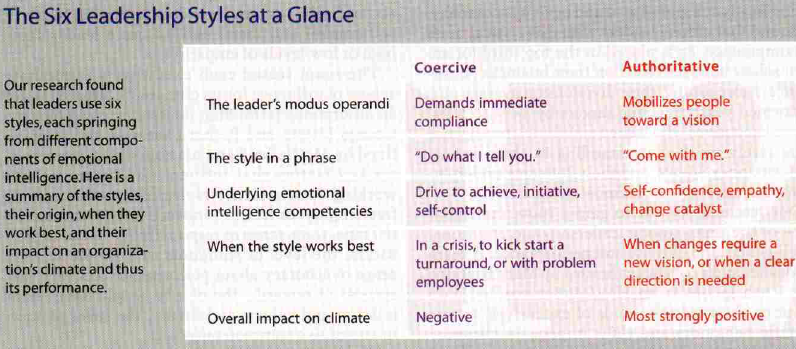
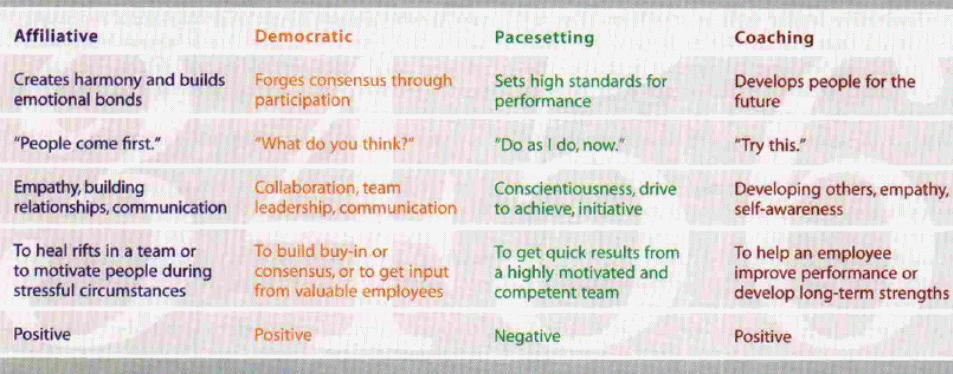
Components of leadership
On their part, while trying to study the multifaceted view associated with project management, Dainty and others (2005) acknowledged that an effective project leader or project manager must fulfil a number of roles, including those of coordinator, facilitator, politician and motivator (p.40). All those roles also topped up as the components of leadership.
While reviewing the link between organizational and project leadership, Cavaleri (2007) proposed that leadership was conventionally linked to organizations, as opposed to projects (p.77). This is because projects did not have the same degree of autonomy as most organizations had and as such the role of project leaders was substantially varying when compared to leading an organization (Cavaleri 2007, p.77).
The author went ahead to identify five essential elements that were advanced by Western philosophers such as Dewey, Peirce and James as employing systematic knowledge leadership necessary for achieving satisfactory project results.
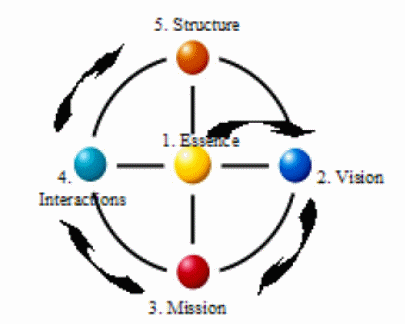
Cavaleri (2007) stressed on the need of establishing or striking a balance amongst the leadership tendencies and styles (p.79). This can only be possible if the project leaders endeavoured to master the above 5 key leadership elements.
Project management success factors for project leaders
While referring to the works of Slevin and Pinto (1988), Turner and Muller identified the management success factors associated with projects of Information Systems (p.56).
Table 2 showing project management success factors.
On his part, while referring to the work of Thomson (2007), Cavaleri (2007) proposed that “learning and knowledge creation are critical processes also needed to develop highly effective policies for managing complex projects” (p.75).
On their part, Avolio and his group (2004) depicted the leadership components of trust, positive emotions and optimism as the key themes manifest in authentic leadership (p.803). These components are as depicted in the figure below
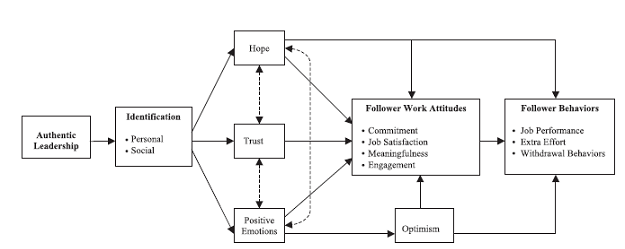
Essential leadership competencies
While comparing the behavioural competency profiles of client based and construction based project managers, Dainty and others (2005, p.44) noted that the two categories of leaders shared most of the leadership competencies as depicted in the following table.
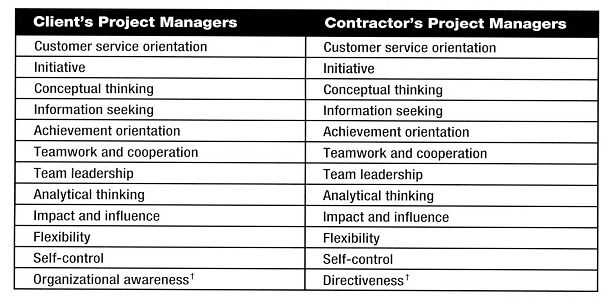
Table 3 comparing the behavioural competencies of production and client-oriented project managers.
From the table above, the two categories of project leaders shared the eleven leadership competencies. However, only two leadership competencies were found to be varying within the two. These were the directiveness and the organizational awareness.
In analyzing the relationship that existed amongst the 12 behavioural competencies as identified in the table above, the three scholars, while referring to the work of Spencer and Spencer (1993), came to note that the identified competencies were dynamically interrelated and mutually supportive to each other (Dainty et al. 2005, p.44). For instance, the initiative competency when keenly analyzed can be taken to be supportive of the following behavioural leadership competencies: customer service orientation, impact and influence and achievement orientation.
Furthermore, while carrying investigative empirical studies to ascertain the behavioural characteristics of project managers as they had been detailed in APMBok (of 2000), the three scholars identified a number of behavioural characteristics in their empirical case study which, though varying in title, matched the behavioural competencies previously identified in the APM 2000. The following table depicted the results of their empirical case study.
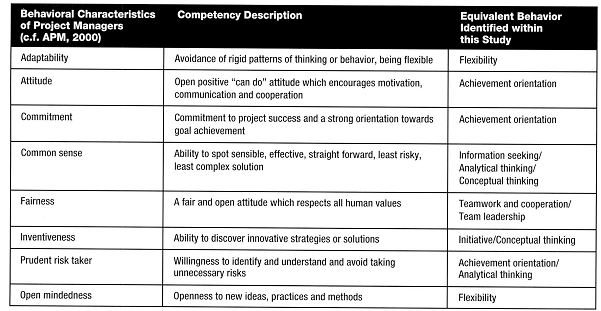
Table 4 showing a reconciliation of the APM and Dainty and other’s leadership competencies.
From the table’s findings, adaptability and open mindedness (in APM work of 2000) were equivalent to the corresponding flexibility leadership competency (as identified in Dainty and other’s work of 2005).
The same three scholars while comparing the general managerial competencies with the managerial competencies as identified in Spencer and Spencer (1993) and Boyatzis (1982 works), the three researchers noted that the managerial competencies of flexibility, customer service orientation and self-control were indentified and therefore present the under general level while self-confidence, assertiveness and developing others were present in Spencer and Boyatzis works and lacking under general competency level. The following table captured the assertion above.

Table 5 showing a comparison of the general project management competencies and the generic competency model.
The following were also identified by various authors as essential leadership competencies necessary for project leaders and managers.
Project leaders should inspire a shared vision
It should be noted that all projects are created based on established visions. To successfully accomplish this vision, it is the role of the project leader to inspire team members into ‘owning, sharing’ and supporting these project visions to become a reality (Avolio et al. 2004, p.810-811).
To inspire a shared vision, project leaders should have clearly envisioned or seen the project end results before the initiation of the particular project. This will help in ensuring that the end results of their projects fulfil customer and corporate objectives.
Furthermore, though having a project vision is considered a worthy achievement, it will be of no use if the project leader failed to enlist other stakeholders to share the project vision with. As such, a project leader should conscientiously approach every project stakeholder at his/her own interest and skilfully communicate the vision in a manner that the stakeholders will have no alternative but to buy into the project vision.
Project leaders should empower others to act
The project leader should constantly build collaborative team spirits by forging relationships amongst team members and encouraging and fostering their collaboration (Goleman 2000, p.79). This virtue restricts on intimidation and bullying but supports strongly the strengthening of team members to provide power for the project leader- an unstoppable combination for achieving project aim and goals
Project leaders should enforce learning
Cavaleri (2007) stressed on the importance of project leaders enforcing learning when he proposed that project leaders ought to capture the experience of project employees through use of techniques such as post completion reviews, and codifying the findings in company procedures to be used as part of a larger initiative to develop other professionals and other new project managers (p.73).
Project leaders should establish good cooperation with the project sponsors
In their research, Helm and Remington (2005) averred that the project leader should strive hard to establish sound relationships with the overall financier (sponsor) of the project (p. 56). According to the two researchers, a sound cooperation between the project leader and the project sponsor will lead to the latter giving the former high-level support needed for achieving project targets.
In studying the existing relationship between these two important project stakeholders, the two scholars had acknowledged that in most cases, the project managers had employed survival tactics to coerce the sponsors into supporting their projects. Some of these survival tactics included expressing opinions and ideas in an extremely canny manner with the intention of influencing him (the project sponsor) to buy into the project leader’s ideas (Helm & Remington 2005, p.56).
Project leaders should model the way
Besides setting example, project leaders are required to evaluate their results at various project stages and organize for small wins especially for projects that are too complex. As Goleman (2000, p.84) established from his research, individuals or project employees are bound to react positively if it is alluded that their efforts have produced positive results. From this perspective, project leaders are required to adopt various concepts (for instance the sliding planning window concept) to break the larger project into small manageable segments whose results will be regularly reviewed and early wins declared to motivate the team members into achieving the project goals.
The ability to possess emotional intelligence
Goleman (2000) averred that project leaders and managers needed to possess the following four fundamental capabilities of self-management, self-awareness, social skills and awareness under the emotional intelligence competency skills (p.79).
The following table presents a description of the above fundamental concepts.
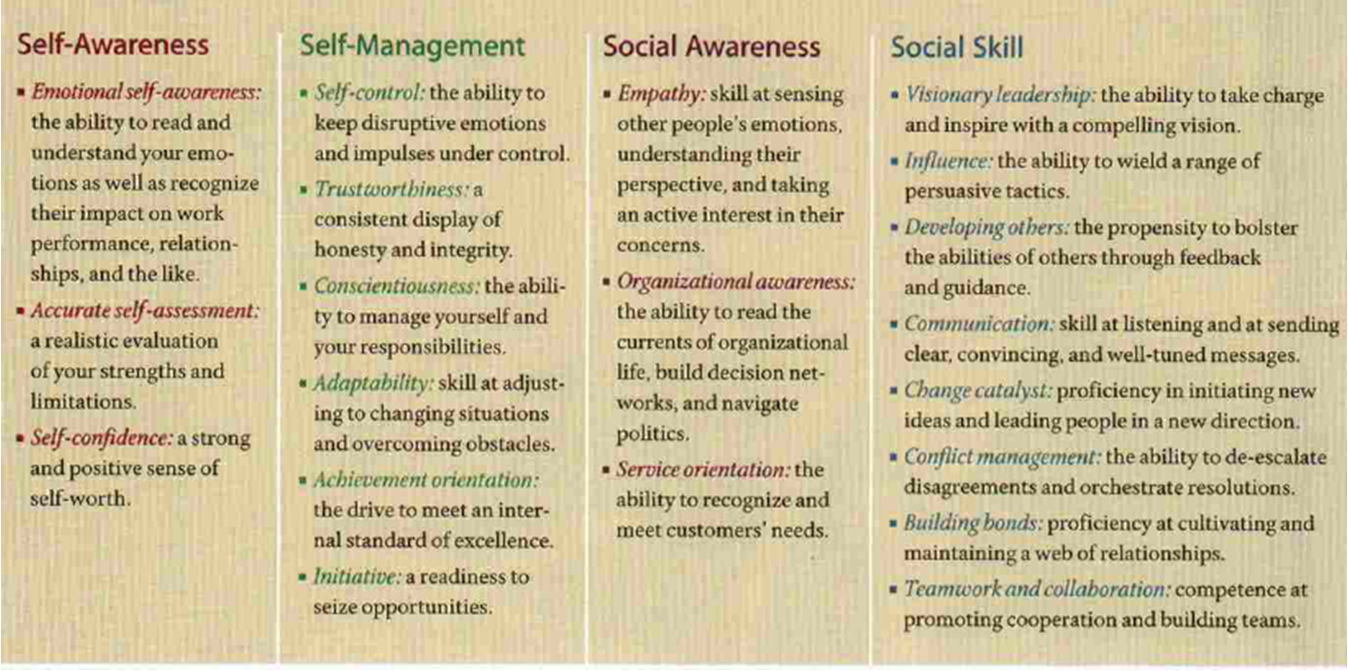
Project Case Study
In the IT project attended by the author, the presence of a leadership style was noticeable from the initial stages.
The project ‘steering’ committee had met in the initial stages and appointed the Chief Systems Engineer (name withheld for privacy reasons) from ZFP as the project leader. He was therefore to act in two roles; as ‘steering’ committee member and as the project leader. The decision to unanimously endorse him arose from the fact that he had successfully steered six projects of such magnitude in his 12 year-period at the company. Other than his experience, members had felt that his assertiveness and team-work spirit were a plus in achieving the project vision.
The project leader, being on schedule, begun his work by appointing his deputy from the project team members. The two leaders were therefore tasked with directing, motivating and coaching team members to develop the FIS system. In achieving the above, they were to observe and or implement the following aspects previously identified in the literature review:
- Identifying problems in the FIS project for solving
- Implementing right things and thus setting good examples
- Inspiring, persuading and nurturing collaboration amongst team members who were mostly system engineers
- Empowering their team members by cultivating a learning culture
- Ensuring an understanding and the well-being of team members
- Clear supervision of project tasks to ensure accomplishment of project objectives
The two leaders, having previously amassed great experience in system development, decided to adopt a ‘participative’ leadership style. This meant that they were to undertake software development roles in addition to their coordination and directing roles.
As a measure of asserting their authority, the two leaders created the following table to help them coordinate project activities.
By frequently updating the above table and setting examples for their subordinates to follow, the project leaders motivated their team members into developing a high-tech Facilities Information System that answered to all client needs.
It should be highlighted that the leader and his deputy had to use their persuasive skills to persuade team members into working an extra day to ensure that the project was completed within the estimated timeframe.
More so, the author would like to stress that the findings highlighted in this case study were observable in the year 2001, the year in which the IT project was undertaken. The findings in this project may therefore vary with findings with the most current IT projects since 10 years down the line is a relatively longer time in the ever-changing IT industry.
Discussion of the findings
The senior most project leader had employed several leadership principles and characteristics to influence team member activities. The following table identified the principles or characteristics of influence and how the team leader skilfully implemented them.
Table 6 showing how the project leader implemented various leadership principles and qualities.
The succeeding sub-sections have been tackled by drawing inferences to the case study findings.
The influence of project leader
As previously highlighted in table 2, the overall project leader had been chosen best on his skills and experience. And as such, he did not disappoint the trust that had been bestowed on him by his employers as he skilfully handled all the challenges that arose in the course of implementing this project. For example, he had successfully negotiated for additional funding from the project sponsor (who was the Chief Finance Officer); thus ensuring that team member activities were not interrupted or delayed in any way. In doing this, it should be noted that this project leader had implemented one of the best qualities associated with good leadership; that of establishing a working relationship with the project sponsor. As Helm and Remington (2005) noted, senior most project leaders needed to establish sound relationships with the project sponsors to ensure that their projects were accorded the needed high-level support necessary for achieving project success (p.56).
Also, in one of his noticeable achievements, this leader had set the example for his subordinates by developing a unique component of the FIS module. He had assigned himself the task of developing (through coding) a communication module for the larger Facilities Information System. His final module had captured all RSAF’s requirements and had been praised at its testing stage for its ease of interaction. This action motivated other team members into working ‘smart’ to achieve best results. One year into the project, an advanced Facilities Information System that answered to RSAF’s specifications had been developed to the satisfaction of all stakeholders involved in the project.
In creating a component to the required specifications, the project leader had implemented the leadership style of pacesetting as articulated by Goleman (2000). In his work, Goleman (2000) had highlighted that this leadership style involved the project leader being initiative, setting high standards of performance and adopting a ‘do as I do’ principle (p.83).
Team members understanding of project leader’s expectations
The benefits associated with building of teams to implement project assignments can be best illustrated with reference to the ZFP project. This is because team members had shown high levels of cooperation and commitment in all project stages. For instance, when they were requested by the project leader to extend their days of work by one day in order to cover the project workload, members had responded in the affirmative. In adhering to this directive, team members unanimously agreed to report to duty from Monday to Saturday, as opposed to Monday to Friday. In accepting the senior most leaders’ request, team members had evidenced that the project leader had been endowed with the leadership competencies of inventiveness and analytical thinking as articulated in Dainty and others (2005, p.45).
Likewise, team members had frequently updated their leader on the progress of their assignments. As such, the project leader was in a position to give detailed project status reports to all the stakeholders of this project. This gesture showed that the project leader and the team members embraced the spirit of teamwork and cooperation-which was one of the key leadership competencies as postulated by Dainty and others (2005, p.46).
Project leader’s response to team members’ expectations
In rewarding team members for their cooperation and loyalty, the project leader had established a proactive defence for team member’s rights. This was evident when he took it upon himself to skilfully negotiate for their reward for having volunteered to work on Saturdays. Due to his bargaining power, team members were to be rewarded with a payment of $20 for each hour worked on Saturday. Other than the improved reward scheme, the project leader had successfully negotiated for a suitable working environment. His negotiation role had seen the project engineers given a luxurious floor in one of RSAF’s modern complexes to undertake their tasks from.
In volunteering to negotiate for team members’ rewards, the project leader had demonstrated two unique characteristics as postulated by Turner and Muller (2005, p.56): problem solving skills which required leaders to solve unexpected scenarios.
Commitment of team members
Tellingly, team members had evidenced their commitment in all project phases. For instance, by deciding to sacrifice their ‘resting’ time on Saturdays and reporting to duty, members had shown that they fully owned and supported this project. Moreover, members had developed and delivered high quality software units- that were later on merged to form the larger FIS. These, amongst others, were enough to evidence their commitment to this project thus further highlighting that they had nurtured collaboration and shared the project vision; key variables that determined project success according to the work of Dainty and his group (2005).
Assessment of my observations
In the course of my study, I had comprehensively analyzed the themes that were associated with this important topic of project management. Amongst the themes which I had successfully covered in class and on my own review included the types of leadership and the competencies/characteristics of a good leader. In this project, I can confidently assert that the forms of leadership styles that were implemented across various project stages were transactional, affiliative and pacesetting leadership styles.
Transactional leadership style was implemented in the project implementation stage when the project leader and team members embraced a series of mutual exchanges amongst themselves. This, according to Turner and Muller (2005) work constituted a transactional leadership style. Moreover, pacesetting leadership style was implemented when the project leader set high standards of performance which were to be achieved by the team members. This according to Goleman (2003, p.83) constituted a pacesetting leadership style. In addition, the affiliative leadership style was demonstrated in this project when the project leader kept on motivating team members during stressful circumstances to ensure that they achieved the project vision. This according to Goleman (2000, p.83) constituted an affiliative leadership style.
In addition, I learnt that a participative approach to any leadership style was a key aspect of achieving leadership roles. This was so because the project leader in undertaking software development roles had set a good example for his subordinates to adopt.
Furthermore, in this case study, I have found that there was need for the project leader to consider minor aspects which, though appearing invaluable, had a great impact in determining the success or the failure of any project. This include amongst others the need to establish a working relationship with the project sponsor to ensure high level support is accorded to the project thus ensuring its sustainability and its smooth running (Helm & Remington 2005, p.56).
Enhancing project effectiveness
In this IT case study, I propose the following to be incorporated in future ZFP projects to enhance their effectiveness:
The management should regularly liaise with the project leader before making any decisions that are bound to affect the project. This need arose from the fact that the ‘steering’ committee had single-handedly set 10 months as the project timeframe. This decision had been arrived at despite the fact that they did not understand the workload that was to be involved in this project. Five months into the project, the project leader had come to discover that the project was to last for an estimated 15 months. This meant that its pre-determined budget had to be adjusted by a high of $ 20,000. This scenario had forced the project leader into persuading his team members to work an extra day (Saturday) of each week to reduce on the backlog. Despite the team members’ efforts, it should be reported that the project took 12 months for its conclusion.
As Cavaleri (2007) noted, the project leaders should be left to take charge of most operations or the activities of project at the expense of other stakeholders (p.73). This is so because as the participative implementers of the project, they are better placed to address or determine justifiable estimates relating to project processes.
Conclusion
In this case study, the author has carried out detailed review of the leadership style concepts. In this case study, through reviewing literature, the author has identified the following as some of the essential leadership competencies for good managers: honesty, inventiveness, analytical thinking, optimism, flexibility, self-control, and team-leadership and achievement orientation amongst others. In addition, the author identified motivating, directing and coaching as some of the sub-components that summed up the leadership component. Likewise, enforcement of the results to be achieved and the cultivation of a learning culture were some of the principles discussed in this case study.
In addition, a review of the distinction between the project manager and the project leader led to the conclusion that the project leader acted at an advanced level as compared to the project manager. For instance, other than solving routine problems as was the norm with most project managers, project leaders went further to identify the problems to be solved.
Having discussed the above themes, the author summarises with a notion that project leaders have very important roles in the achievement of any project results and as such possession of the most, if not all, of the above discussed themes was the key to their success.
However, in this case study, the author acknowledges that there is need for future research since this case study concentrated mainly on the complexity of the project task. Future research is therefore needed to examine the nature and the uncertainty associated with the project tasks. Likewise, this being an IT project adopted a very different structure as compared to most public or private sector projects. There is therefore need to examine leadership style as adopted and implemented across most public and private sector projects.
Reference List
Avolio, B. J.,Gardner, W. L., Walumbwa, F. L. & May, D. R. (2004) Unlocking the mask: A look at the process by which authentic leaders impact follower attitudes and behaviors. Leadership Quarterly, 15, pp. 801-823.
Cavaleri, S (2007) Leading dynamically complex projects. International Journal of Managing Projects in Business, 1(1), pp. 71-87.
Dainty, A., Cheng, M. & Moore, D. (2005) A comparison of the behavioural competencies of client-focused and production-focused project managers in the construction sector. Project Management Journal, 36(1), pp. 39-48.
Goleman, D. (2000) Leadership that gets results. Harvard Business Review. Web.
Helm, J. & Remington, K. (2005) Effective project sponsorship: An evaluation of the role of the executive sponsor in complex infrastructure projects. Project Management Journal, 36(3), pp. 51-61.
Keegan, A. E. & Hartog, D.N. (2004) Transformational leadership in a project-based environment: A comparative study of the leadership styles of project managers and line managers. International Journal of Project Management, 22 (8), pp. 609-617.
Turner, J. R. & Muller, R. (2005) The project manager’s leadership style as a success factor on projects: A literature review. Project Management Journal, 36 (2), pp. 49-61.